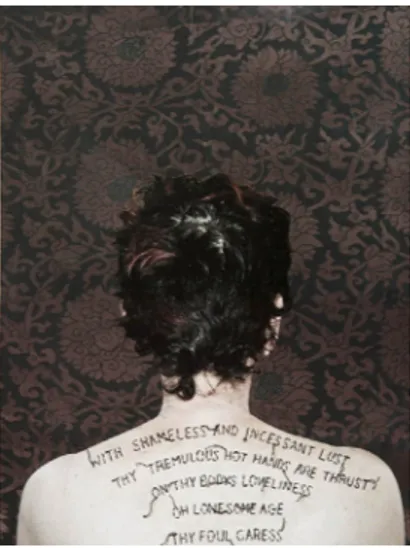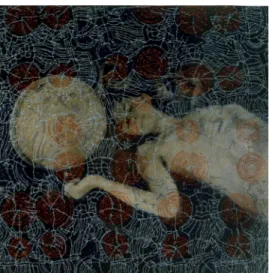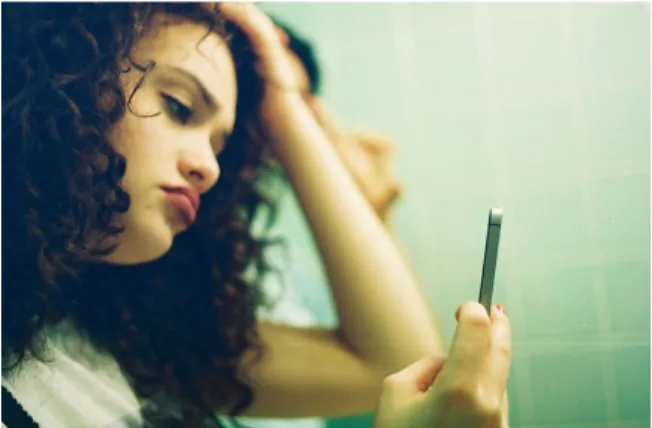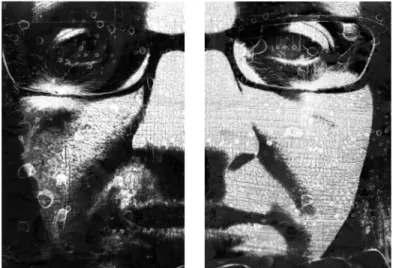SARAH By
Sarah K. Lazure April, 2017
Director of Thesis: Angela Franks Wells Major Department: School of Art and Design
As a woman artist, I create my own places to exist. My self-portraits are full of emotion, thought, and creative energy and are made to engage the viewer in an intimate
moment. I work by transforming thoughts and emotions into photographs and then alter the image. The creative process is an intuitive call and response between me and the materials. I continue to manipulate the surface until the discourse is complete and the piece is balanced. I empower my gaze and the intimacy of prolonged eye contact to portray the strength of my vulnerability and my desire to connect, acknowledge, and interact with my viewer. My gaze is commanding and requests your return gaze. There is no question that I am looking at you.
SARAH A Thesis
Presented To The Faculty of the School of Art and Design East Carolina University
In Partial Fulfillment of the Requirements for the Degree Master of Fine Arts in Art
By
Sarah K. Lazure April, 2017
SARAH By
Sarah K. Lazure APPROVED BY:
DIRECTOR OF THESIS: _________________________________________________ Angela Franks Wells, MFA
COMMITTEE MEMBER: _________________________________________________ Daniel Kariko, MFA
COMMITTEE MEMBER: _________________________________________________ Jim Tisnado, MFA
COMMITTEE MEMBER: ________________________________________________ Kate Bukoski, PhD
DIRECTOR OF THE
SCHOOL OF ART AND DESIGN: _________________________________________ Kate Bukoski, PhD
DEAN OF THE GRADUATE SCHOOL: _____________________________________ Paul J. Gemperline, PhD
DEDICATION
ACKNOWLEDGMENTS
I would like to thank Angela Franks Wells for being a wonderful mentor and friend. And the hugest thank you to my wonderful husband – for everything.
TABLE OF CONTENTS
CHAPTER 1: INTRODUCTION ...1
CHAPTER 2: CONTEMPORARIES ...3
CHAPTER 3: THE GAZE ...13
CHAPTER 4: EXHIBITION: SARAH...17
CHAPTER 5: CONCLUSION ...22
REFERENCES ...23
“Art provides me, as well as other women, with new ways to see ourselves and others; art helps us transform our perceptions of reality” (Fogarty and Reinecke 262).
I am proud to be a woman, a woman artist, a woman photographer, a woman making self-reflective work. I construct my own places to exist. I am a participant, not an observer.
I transform my thoughts and emotions into my self-portrait photographs and then alter the image. I have a visual “conversation” with my work as it evolves; my pieces metaphorically speak to one another. I often work on multiple images at the same time, allowing the iterations to inform each other as they uniquely respond to the actions of my hands. A print is never a failure. If a print is too dark, then I will paint a layer of a lighter color on top and even sand some of the paint back to create depth of the surface. If a print is too light, then I will use it as a base to create another image on top of it. I value the juxtaposition of the intentionally made marks on the surface of a print and the marks created by the process itself. While physically working on a piece, I spend time and listen to my responses as I explore the image. Each response becomes a new layer. I manipulate the surface until the discourse is complete and the piece is balanced. How these overlapping images interact is the core of the visual conversation that I conduct with my images.
“Because art making is an active and ongoing dialogue between artist and object, I realized that I had the power to change any imagery I created by going back into the piece with a pen and brush – a line here, shading there. In this way, I was empowered by the artistic process, its flexibility and mutability. And even though altering an image can lead to even more disturbing imagery, this risk-taking aspect of the art process helps to balance an artist’s sense of control” (Fogarty and Reinecke 261).
2
There is a large risk in making work like this. The risk is amplified by using my own face as a canvas for the manipulation. These manipulated portraits tell my truth which is revealed by literally defacing and destroying the geographical representation of me. My truth is a visceral experience created by the tear down and buildup of multiple versions of my face. The portrait is not a literal geographical description of a person. Portraits communicate something about a person, not only physically but emotionally, spiritually, and intellectually. The concept has been done for a long time by artists; the most successful ones are not the most literal. Audiences are drawn to substance and meaning because they offer more than a description.
CONTEMPORARIES
Self-portraiture has existed for as long as human history, but not until the early Renaissance did artists depict themselves as the main subject or as important characters in the work. Pioneer photographers such as Robert Cornelius, Hippolyte Bayard, and Constance Talbot, wife of Henry Fox Talbot, posed in their own
photographs as a testament of the achievements of photography.
“The portraiture of past centuries takes a different stance towards the self: the sitter’s appearance is conventional and reveals role and status. In contemporary depictions, however, appearance is a self-presentation and reveals personality” (Crozier and Greenhalgh 31).
Self-portraits have been an outlet for feminist expression for decades. Artists such as Frida Kahlo, Cindy Sherman, and Francesca Woodman have been prolific makers of portraits using their own bodies; these images are important to the narrative of female representation and dominant visual culture.
One of the most well-known artists of self-portraiture must be Frida Kahlo, who was the first major international artist to use herself as the central subject of almost all her work. Kahlo obsessively focused on her body as a comment about her internal person as well as about her external environment. Consumed with her self-image, she famously said, “I paint myself because I am so often alone and because I am the subject I know best.” Using herself as a subject allowed her to question and interpret her multifaceted identity. As she repeatedly reconstructed her body within her paintings, she revealed her many, often conflicting, identities as if she was creating each one through a visual stream of consciousness.
Cindy Sherman addresses the roles of women and the representations women assume to function within our society. Sherman’s portraits reveal the stereotypes that
4
have molded women throughout history and more recently through advertising, cinema and the media. Whether she is recreating film stills from iconic movies of the 1950s or European paintings, she is commenting upon how men have portrayed women as objects of desire in art and media. She concentrates on the relationship between self and the world. She dons costumes to assume the roles of female
characters while consistently acknowledging the viewer’s
gaze to confront the stereotypes she portrays. The work started a conversation to break down the stereotypes of women. Cindy Sherman has effectively influenced a generation of artists about the construction of identity and the importance of conceptual ideas in portraiture.
Francesca Woodman made numerous images of herself during her short life – full of mystery, humor,
intriguing compositions and an intense vulnerability. Her use of soft focus and shrouded ghost-like figures in conjunction with empty rooms and natural light allows the audience to make their own conclusions about the images. Part of the intrigue about her work goes beyond her thoughtful images to the mystery surrounding her enigmatic life and suicide.
Figure 1. Cindy Sherman, “Untitled Film Still #14” from the Film Still Series, 1978.
Figure 2. Cindy Sherman, “Untitled 193”, 1989.
Figure 3. Francesca Woodman, “Polka Dots, Providence, Rhode Island”, 1976.
5
Arguments include that Woodman was a misunderstood yet talented photographer; that Woodman’s depression overshadowed her work; that Woodman was attempting to become one with her surrounding; and that Woodman was somehow defying the male gaze through her presentation of imagery. Viewers expect that nude females in photography are seen through the eyes of men, but readily accept Woodman’s nude form as a force of life, not an object. Woodman stripped away the artifice of what
women are supposed to be and explored how she could physically remove herself from her audience. Her disappearance into the dilapidated structures reinforced her inability to become an object of desire and forced the attention onto her intimacy and self-discovery.
The self-portraits of Kahlo, Sherman, and Woodman differ from my images on multiple levels but are innately intertwined. Kahlo painted herself as a type of therapy to cope with the trauma inflicted on her body. Kahlo did not idolize her body in her portraits; they not only serve an intensely cathartic purpose but comment upon the social and economic aspects of her life. Her images often communicate the idea of duality – how Kahlo saw her image versus how she physically looked; feminine versus masculine; American versus Mexican; fertile versus infertile.
I can link my work conceptually to Frida Kahlo’s self-portraits through the idea of reassembling the fragmented pieces of the body and soul. While my work is connected to Kahlo’s through self-reflection, my work is related to Cindy Sherman’s through the investigation of female identity and feminine stereotypes. I attempt to show a realistic view of myself at a specific moment while Sherman assumes the persona of another woman by wearing costumes and performing for documentation.
6
Cindy Sherman and Francesca Woodman are contemporaries of one another but their images are rarely compared. Both vigorously explored the nature of identity. Sherman explored the universal female identity through role-playing while Woodman explored it through introspection. Sherman’s recreations are in response to the pressure to conform to the images of perfection circulated through advertising, cinema and
the media. “Challenging sexist thinking about the female body was one of the most powerful interventions made by contemporary feminist movement” (Hooks 31). Like the composition of Woodman’s images, I am intrigued how the intent of the image making can alter the outcome of how the work is perceived. Even though Woodman is unclothed in many of her images, her body is seen without the objectification of the male gaze. Woodman’s portraits are easily connected to her implied mental anguish because of her deliberate vulnerability but Sherman’s desire to dress up and play the part of others is never questioned. These women were inspirational to me as a young photographer and influenced how I thought about my own images.
Even with so many women photographers exploring self, femininity, and identity, there are still women who perpetuate the clichés and stereotypes that have plagued women for decades. In exploring femininity and identity, some women focus on
sexuality, family, mental health, and sadly preserving the male gaze. Nan Goldin’s work focuses on the power of female sexuality; Sally Mann’s work explores the dynamics of motherhood and family; Diane Arbus and Mary Ellen Mark investigate the stigma of mental health; Jesse Dugan and Liz Cohen explore gender, identity, and sexuality. Realizing that those were ideas that I was not interested in, I looked to contemporary women who are using photography as a tool to communicate their struggle with self.
7
“Posing for a self-portrait, which requires a distinctive form of self-scrutiny, is a different activity than posing for a portrait, or for a snapshot picture. A self-portrait requires not just self-examination, but a presentation of the self to itself. The automatism inherent in photography makes it possible to pose for self-portraits in radically new ways, and, crucially, even if the apparatus is an entirely automatic mechanism, this does not inhibit the artist’s agency to pose in a way that creatively defines the image as a self-portrait. Instead, automatism is what makes it possible for an artist to have this distinctive form of creative self-awareness” (Wilson 63).
In the series simply titled “Self-Portraits,” Jen Davis is addressing issues
regarding beauty, identity, and body image. Her work not only speaks about the larger idea of beauty and our bodies, but also in a
subtle way, discusses how photography brings us to conclusions about our own appearances and desires. Her self-portraits explore
insecurities and search for acceptance in a world where body shaming is prevalent and outrageous. She also questions what it means to represent the self. In many of her
photographs, she visually acknowledges the camera and the audience. Her connection through the camera appears to be honest and therefore creates an unconscious bond with the viewer. In the larger scope of her work, the intimate details she shares through her images mirror the issues many have with their appearance because of society, family, or personal reasons.
To show what she refers to as vulnerability, Ariana Page Russell photographs the transparency of her skin and its reaction to being touched, a physical metaphor to internal activities. Due to a condition called dermatographia, Russell’s skin shows a
Figure 4. Jen Davis, “Fantasy No.1” from Self-Portrait Series, 2004.
8 temporary record of every interaction she encounters. Russell uses the hypersensitivity of her skin to draw designs and images onto her skin. By photographing these reactions, she is transforming the idea of beauty through the fragility of her body. Russell’s work reinforces that everyone has
flaws and insecurities; flaws and insecurities are the universal things that everyone has in common. Russell uses her skin as a canvas as the backdrop to a larger conversation. In addition to photographing the reactions of her skin, Russell is creating wallpaper and decals from the patterns created by those reactions. In creating these domestic objects, she is commenting on women’s roles and how women are perceived. Women are viewed as less than perfect when they, and metaphorically their homes, are different from the beauty standards of our society.
Like Jen Davis, I see the creation of my self-portraits as a way to understand myself better and to question the beauty standards that make me feel inadequate. Davis made herself vulnerable for the camera, connecting with her audience through several visual details including her longing gaze. Even though we are tackling the issues through different concepts, my work closely parallels Jen Davis’ self-portraits. Like Russell, I am using the body as a canvas. The skin of my face tells a story through
Figure 5. Ariana Page Russell, “Flora” from the Skin Series, 2006
Figure 6. Ariana Page Russell, “Belle Etoile” from the Dressing Series. Installation view of the wallpaper, 2008.
9
all the layers of manipulation that create the final image. Russell’s drawings on her skin are fleeting, not lasting more than an hour. She records the reaction of a single moment as a document of the physical effect. I create a skin through the process work of my images. The transfers leave a record behind on the surface of the print. Like Russell’s skin, the physical evidence generated by the marks of the hand have a lasting record. In searching for artists who were altering their portraits, it quickly became clear that my self-portraits stood alone in visual and conceptual construction. I found that embroidery was the medium of choice for photographers embellishing their images. These powerful photographic portraits are enhanced by thread as an exploration of female identity. Several women artists are examining their identity with photography and the adornment offered by stitched elements. This style of expression is an extension of the Feminist art movement of the 1970s. The movement made the association between craft and women’s work, and how that was framed within the art world. Women were often denied showings of their work because they were supposed to be in the paintings, made by men, not creating the paintings themselves. Feminist artists in the 1970s made
work to celebrate the traditional crafts of women and to comment upon the unbalanced gender equality in society, especially in the art world. Today, the use of thread still
10
invokes the archaic notion of “women’s work.” The pairing of thought-provoking portraits with “women’s work” continues the Feminist conversation of gender equality and the exploration of feminine identity.
Sandra Klein’s work focuses on self-portraits that are layered with embroidered text which reflect her conclusions of aging, loss, and family. Her images include poems stitched onto the canvas of her skin; the poems are of universal emotions, like loneliness. Klein places various parts of the body against patterned backgrounds, creating simple compositions in their isolation.
Marina Font has created several bodies of work that explore feminine identity and sexuality. Her newest body of work, Mental Maps, investigates the inner working of the mind and utilizes thread to make the connections between the biological and emotional entities of the mind. In an interview, Font explains the concept of her series, Mental Maps: “In this series, I begin with a black and white photograph of a female body and make of these neutral photographs a canvas for recreating, through the physical labor of sewing, metaphors of the mind’s systematic representation of the world” (Smithson lenscratch.com).
Melissa Zexter uses embroidery and drawings created with thread to design maps and memories on portraits. The thread acts as a physical connection between
Figure 8. Sandra Klein, “The Caress” from the Stitched Self-Portraits Series, 2012.
Figure 9. Marina Font, “Connections+(Head)” from the Mental Maps Series, 2014.
11 the artist and the subject. Zexter utilizes the thread to respond to the subject of her photographs. The combination of traditional “women’s work” with the technology of photography provides a fresh perspective on feminine identity and women’s place in the art world.
While there are many differences between my work and that of Sandra Klein, Marina Font, and
Melissa Zexter, we are all altering our photographs to comment upon individual and collective feminine identities. We each approach the idea of personal maps uniquely. I print fictitious maps as layers within the composition of my portraits. Some maps are graphic and rectilinear in design, mimicking mark making and the stitched line of embroidery. Other maps are organic in the landscape that they create when printed, transforming the structure of my face. While both maps have been created by my hand, there is another type of map that has formed simply through the process of image making. This third type of map is unique to the creation process and communicates ideas associated directly to the materials from which they are constructed. These maps not only guide the viewer through the composition but each articulates an abstract concept of why I make images. I include these maps as a metaphor for my creative process. I see this process as a path that appears straight and narrow but is anything but that. Navigating through the complexities of creating artwork is not a clear-cut road on a single plane.
Just as the maps serve as a representation of my creative process, the physical
Figure 10. Melissa Zexter, “Russian City” from Maps and Memories Series, 2013.
12
manipulation of mark making and mixed media layering represents my emotional self-reflection. By examining my work in this manner, I am learning to accept myself as is and to unpack all the stereotypes of female roles and the stereotypes of being a woman artist. My self-portraits focus on the assertive gaze of my eyes. My commanding eye contact exposes my truest interpretations of myself to the audience. The gaze and the images themselves are androgynous and lack any sort of enhancements which reflect beauty standards.
THE GAZE
My work is in stark contrast to the traditions of the male gaze and the beauty standards idealized in commercial photography. The male gaze is a term applied to the way women are portrayed in visual media; men are empowered by the objectification of women. It is an enormous factor in the unattainable expectations of beauty perpetuated by visual representations of women. Women are made into desirable objects for male voyeurism.
I portray myself as is, without traditional enhancements. The photographs are captured without controlled studio lighting, resulting in textured skin and dull eyes. I concentrate on capturing my face, my solemn expression, and the blatant stare of my eyes in the photographs that communicate a variety of emotive concepts – contemplation, longing, sadness, empowerment. The portraits are then manipulated digitally as well as physically by layering other images and making marks with a variety of tools. This is a subversive action against the beauty standards idealized in the media, the film industry, and social media outlets. My gaze asserts my identity and personifies my need to protest the overwhelming objectification of women.
Contemporary judgement of women is based on unattainable expectations of beauty. Photography is guilty of perpetuating beauty standards, stereotypes, and gender roles. Women work through these imposed stereotypes in different ways and challenge gender roles by owning their sexuality, asserting themselves as mothers, and seeking validation for their choices. Women today are plagued with insecurities from their own critical judgements as well as the overwhelming criticism from the media, the fashion industry, and the world of celebrities. Women are fighting back and asserting their
14
own self-acceptance. According to Lorrie Shepard, “self-acceptance is an individual's satisfaction or happiness with herself, and is thought to be necessary for good mental health. Self-acceptance involves self-understanding, a realistic, albeit subjective, awareness of one's strengths and weaknesses” (140).
The female gaze is the antithesis of the male gaze; women viewed as objects of desire are replaced by the assertion of women’s identity. The female gaze declares that beauty is not artificial and femininity is intricately complex.
To apply the theories of John Berger, the selfie allows women to look at themselves, instead of watching themselves being looked at. Sadly, they are still inviting others to objectify them. Selfies encourage the self-serving cycle to look and to be looked at. Selfies ask men, and women, to view, judge,
objectify, and dismiss the person in the image. Women who are using selfies as a tool to break this cycle have a hard road to travel. Petra Collins is a young female fashion photographer examining the selfie culture among teenage girls. She has spoken out against hypocrisy towards women and their bodies; she uses photography to tell the emotional stories of her subjects. For Collins, the selfie grants power to young women who desire to create their own imagery and curate how and where those images are distributed.
“As a longstanding tradition ever since the invention of photography, the self- portrait represents what makes humans unique: our highly developed self- awareness that motivates us to capture and preserve ourselves in some material way, so we can re-experience, re-examine, and perhaps better
Figure 11. Petra Collins, “Untitled” from the Selfie Series, 2013.
15
understand not just ourselves, but also the very process of capturing our own self-awareness. But it was not until the invention of digital photography and the Internet that this endeavor blossomed among both professionals and amateurs. Everyone had the opportunity to not just take self-portraits, but also to shoot as many as one desired at no extra cost, to choose the best results immediately by viewing the camera LCD screen, to edit the images oneself on a computer, and to share them online” (Suler 175).
If selfies are attempts to showcase the “best of” a person, how does that affect images of a person which do not share the idea of perfection? With the advent of digital technologies and the smartphone camera, a person can easily take hundreds of photos before deleting and editing down to one final image that showcases the “best of”. The obsession with perfection in our outward projection is fueled by the ease and immediacy of the digital means for making images.
Some of my images started out as selfies, photographs taken with my
smartphone, within arm’s length. Not until I began to focus on my face and make eye contact with the camera did I feel the need to defend my images against the trend of selfies. While the act of turning the camera towards myself seemed natural, I was concerned that my work would be critiqued as narcissistic. There is a distinction between my motivation to make images and the implied reasoning behind the selfie. Many selfies engage in the objectification of the body but my images celebrate the imperfect. The major difference between my work and the selfie is the physical nature of my images. My work is very tactile and the elaborate layers of imagery and materials enhance the experience a viewer can have. My images are self-aware; I am seeking growth in my understanding and acceptance of who I am. While I might not show the “best of” myself in each image, I am striving to show viewers who I really am.
16
extremely democratic way of making art. The medium once was limited to those with a specific knowledge of chemistry and equipment. The advancements in photographic image making are now readily available to the masses. Photography is not a
clearly defined medium with a clear aesthetic. There has been a shift in the idea of photography as truth. In the digital age, the digital photograph is assumed to be false because of the capabilities of the technology.
I am not concerned with photographic truth; the photograph is just the base layer of my imagery. The photograph is descriptive of my physical appearance but is not a good description of who I am. I transform these photographs into pieces of art which reveal my truths through the physical manipulation of the image.
EXHIBITION: SARAH
The exhibit, Sarah, consists of more than forty self-portraits and an installation of over one hundred exploratory self-portraits.
Through these self-portraits, my gaze fills the gallery and commands the
attention of my audience. The massive amount of images allows me to own the space. I fill the space with who I am.
Figure 12. Installation View.
18
The exhibit’s intention is to catch the audience within the intersection of my eyes, regardless of where they are in the space.
I am compelled by the idea that my eyes can animate an entire room.
Figure 14. Untitled artwork from exhibition.
19
I have searched for my place as a woman – as an artist – I have learned that only I can empower myself.
As I assert my gaze, I demand the return gaze from my viewer. I request that my viewer make an investment in me.
Figure 17. Untitled artwork from exhibition. Figure 16. Untitled artwork from exhibition.
20
I ask my viewer to take time to look in my eyes and see the openness and vulnerability that I am sharing.
The layers and texture created by my process of working is enticing. The texture begs to be touched.
Figure 18. Untitled artwork from exhibition.
To stand back and view the multiple faces all at once is a magical moment. The same contemplative stare is present in each image, which as been manipulated in so many ways. Each tells a story and collectively, they tell my truth.
21
CONCLUSION
I once questioned if the work I was making was stronger than I was. I saw the work as a projection not a reflection. After completing this body of work, I know that we are equally strong. There is no doubt; I am looking at you. My gaze demands your attention. I am here and I am who I am. My method of working is unique to me; I have created my own place to exist. I will continue to make work that explores Sarah.
REFERENCES
Crozier, W. Ray and Greenhalgh, Paul. “Self-Portraits as Presentation of Self”. Leonardo, 21:1 (1988): 29-33. JSTOR. Web. 05 April 2016.
Duffin, Debbie. “Exhibiting Strategies.” New Feminism Art Criticism. Ed. Kathy Deepwell. Manchester: Manchester University Press, 1995. 62-69. Print.
Falini, Daniela. “Frida and Her Obsession of Self-Portraits: Fetishism or Idolatry?” Frida Kahlo and Contemporary Thoughts. Web. 16 May 2016.
www.fridakahlo.it/en/selfportraits.php
Fogarty, Mary Beth and Reinecke, Peggy A. “Everything You Make Is a Self-Portrait.” Images of the Self As Female: The Achievement of Women Artists In
Re-envisioning Feminine Identity. Ed. Kathryn N. Benzel, Ed. Lauren Pringle De La Vars. Lewiston: Edwin Mellen Press, 1992. 261-274. Print.
Hooks, Bell. Feminism is for Everybody: Passionate Politics. South End Press, Cambridge, MA, 2000. Print.
Kim, Ae-Ryung. "Resisting the Power of the Gendered Gaze: Metonymic Self
Description through Digital Photography." Asian Journal of Women's Studies, 18.4 (2012): 45-70. Web. 24 May 2016.
Meskimmon, Marsha. Women Making Art: History, Subjectivity, and Aesthetics. Routledge, NY, NY, 2003. Print.
Molinary, Rosie. Beautiful You: A Daily Guide to Radical Self-Acceptance. Berkeley, California: Seal Press, 2010. Print.
Rawlings, Kandice. “Selfies and the History of Self-Portrait Photography.” Oxford University Press. November 21, 2013.
blog.oup.com/2013/11/selfies-history-self-portrait-photography/
Role Models: Feminine Identity in Contemporary American Photography. Washington, DC: National Museum of Women in the Arts, 2008. Print.
Shepard, Lorrie A. “Self-Acceptance: The Evaluative Component of the Self-Concept Construct”. American Educational Research Journal, 16.2 (1979): 139–160.
JSTOR. Web. 23 November 2016.
Senft, Theresa M. and Baym, Nancy K. “What Does the Selfie Say? Investigating a Global Phenomenon”. International Journal of Communication, Volume 9 (2015): 1588-1606. IJoC. Web. 05 April 2016.
Smithson, Aline. “Marina Font: Mental Maps” Interview, January 17, 2017. lenscratch.com/2017/01/marina-font-mental-maps/
Suler, John. “From Self-Portraits to Selfies”. International Journal of Applied Psychoanalytic Studies, 12:2 (2015): 175-180. Wiley Online Library. Web. 16 May 2016.
Tifentale, Alise. “The Networked Camera at Work: Why Every Self-Portrait is Not a Selfie but Every Selfie is a Photograph.” Riga Photography Biennial 2016. www.academia.edu/23048334/The_Networked_Camera_at_Work_Why_Every_ Self-portrait_Is_Not_a_Selfie_but_Every_Selfie_is_a_Photograph
Wilson, Dawn. M. “Facing the Camera: Self-portraits of Photographers as Artists”. The Journal of Aesthetics and Art Criticism, 70: 1 (2012): 55-66. JSTOR. Web. 05 April 2016.
Wortham, Jenna. “The Female Gaze.” New York Times Online. 25 June 2015. www.nytimes.com/2015/06/28/books/review/the-female-gaze.html?_r=0
APPENDIX A WORKS CITED
[Figure 1] Cindy Sherman, “Untitled Film Still #14” from the Film Still Series, 1978. www.moma.org/interactives/exhibitions/2012/cindysherman/gallery/2/#/32/unti-tled-film-still-14-1978/
[Figure 2] Cindy Sherman, “Untitled 193”, 1989.
www.moma.org/interactives/exhibitions/2012/cindysherman/gallery/7/#/11/unti-tled-193-1989
[Figure 3] Francesca Woodman, “Polka Dots, Providence, Rhode Island”, 1976. Courtesy Betty and George Woodman.
www.sfmoma.org/exhibition/francesca-woodman/
[Figure4] Jen Davis, “Fantasy No.1” from Self-Portrait Series, 2004. www.jendavisphoto.com/index.php?/work/self-portraits/
[Figure 5] Ariana Page Russell, “Flora” from the Skin Series, 2006 arianapagerussell.com/skin/
[Figure 6] Ariana Page Russell, “Belle Etoile” from the Dressing Series. Installation view of the wallpaper, 2008.
arianapagerussell.com/dressing/?i=109
[Figure 7] Guerrilla Girls, “[no title]”, 1985-1990. Installation view from Walker Art Center.
www.guerrillagirls.com/exhibitions/
[Figure 8] Sandra Klein, “The Caress” from the Stitched Self-Portraits Series, 2012. www.sandrakleinportfolio.com/portfolio.cfm?nK=16069&nS=0&nL=1
[Figure 9] Marina Font, “Connections+(Head)” from the Mental Maps Series, 2014. www.marinafont.com/work/#/mental-maps/
[Figure 10] Melissa Zexter, “Russian City” from Maps and Memories Series, 2013. www.melissazexter.com/maps-and-memories
[Figure 11] Petra Collins, “Untitled” from the Selfie Series, 2013. www.petracollins.com/selfie/
[Figures 12-20] Sarah Lazure, Installation images and untitled artwork images from MFA Exhibition, Sarah, 2017.
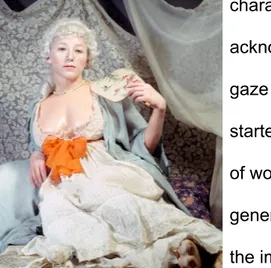


![Figure 7. Guerrilla Girls, “[no title]”, 1985-1990. Installation view from Walker Art Center.](https://thumb-ap.123doks.com/thumbv2/123dok/1778916.2630707/17.918.195.726.733.953/figure-guerrilla-girls-title-installation-view-walker-center.webp)
